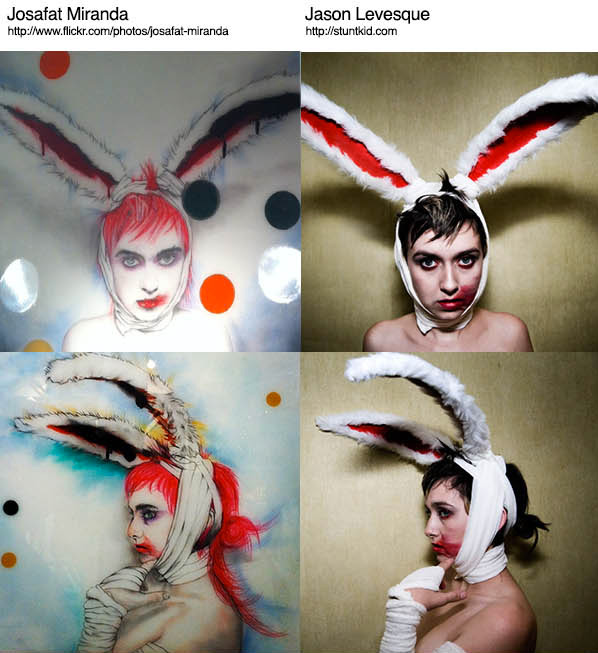
In a society where we are taught that we are individuals and unique in a world so interconnected by technology, social media, the news and just life, there are all of these subgroups that are arising each and every day. And more and more we are asked to cater to the minorities in a manner that they deem acceptable. Now I am not saying that we should not be seeking to help those who need it, or seek to make the world a more equal opportunity place, but is there a proper way to do it?
Is the necessity to challenge the “social norm” and encourage these fringe groups, resulting in making these shock and awe presentations like the one that Nolwen Cifuentes is making with her latest photography series. She is challenging the idea that period sex is somehow bad or gross. This in of itself is good, however the way of social change she is using is where my concern lies. She is making these unnerving pictures of queer women having just engaged in a sexual act during one of their periods. The photos are characterized by the vulnerability of people post-sex and the blood from one of the couples on the skin, face, hands, etc. of the other or both individuals. These pictures are pretty graphic and would be deemed beautiful only in certain contexts and genres. For example such images in support of this lifestyle might only appeal to those actively participating in this lifestyle or those who are supportive of the artist in general
So, the question remains. Is this shock and awe approach to social change conducive to actual change and is it even useful? There have been numerous examples of people using photography to inspire social change with regards to economic inequality. For example, the photographer, William Albert Allard photographed a young boy named Eduardo Ramos, alongside his dead sheep in a small village in Peru, and after the photo went online thousands of dollars were sent to this boy’s family and a water pump was installed in his village. Another example by photographer Lynn Johnson took a picture of an army man and the 22 different meds that kept him alive to show his desperate need for a service dog to keep his mental health and other issues in check. Donations flooded in and now this soldier has Atlas, a companion that he says brings him “A sense of security he hasn’t felt in years”. Both of these examples while somewhat shocking in their content and the material they show do not compare to the really unnerving work of the Cifuentes and her project.
So, we have established that social change can be useful in helping people but what about the world? Let’s look at National Geographic Photographers, the take some of the most beautiful pictures of some of the worlds most endangered animals. These photos are used to showcase the animals to the world and inspire people to be cautious of their own habits and be more mindful of our planet. We could look at the video of the starving polar bear as a result of climate change and feel empathetic and passionate to change the world around us to help fight against climate change. So, imagery works here as well.
But is there a line to be drawn in the sand about how far is too far to take a photo or an image. Is there a limit to what you should share online, as far as content is concerned? Cifuentes is sharing an ideal that exists in a very private place, for the reason that it should be normalized but is the material used the right way to do it?
Personally, I don’t really want to see these pictures showing up in my social media feed, as one, it does not really pertain to me, and two, this is a private practice; if people disagree with it they don’t necessarily need to know about it. This practice is not hurting anyone and, in my eyes, does not require intervention as other practices might so do people need to be subjected to these images. I pose once again, is there a limit to challenging stigma or sparking social change and is this photo project taking it too far?
Final Note: If this story offends you in any way, it was not intended as such. It was only intended as a chance to think about some of the values being brought to the surface in today’s culture.








To be honest, I myself am also uncomfortable with seeing images of period sex – it’s the blood. And even though I am deeply unsettled by blood, I don’t believe that people can really try and censor images of period sex.
Besides, I agree with your point that the reason it’s kind of uncomfortable is to challenge societal norms. And I’m always down for saying “screw it; to hell w/ norms”.
Hello!This is an interesting post! I couldn’t infer the underlying ideas of the image just based on the photo, but judging from the blood and the facial expression, I guessed it might be concerned about something. Personally, I don’t find the photo offensive or unpleasant. Photographing is just a way of expression; it does not need to be idealizing or even aesthetically pleasing. The topic of the photo is intimate, which I could relate to for people who find it uncomfortable if they come across it unguarded. But again, photography is about documenting experiences, it is not always intended to capture the best of the world.
Hi Ranger!
I found your discussion regarding shock and awe tactics in art to be very interesting. I also find that where you seem to draw the line is interesting as well. You seem to express admiration for photos taken of a boy and his dead sheep, the multitude of medications barely keeping a man clinging to life, and a starving polar bear due to the social change this type of art can elicit. The common theme in these three examples is the underlying emotion of sadness that it evokes in the viewer. However, the photography series done by Nowlen Cifuentes doesn’t evoke sadness and it’s not intended to elicit sympathy, so I thought your comparison was a little faulty in that sense.
I also don’t think there should be a “line” as you put it between these bloody images and the public. Sure, you might find blood disgusting, but would you have the same problems with horror movie posters and true crime series which all make use of bloody imagery? Or does it only disgust you because the series is of lesbian individuals specifically? You may not be a lesbian, but the photographs aren’t only for that specific population. The photographs address the stigma surrounding period sex in its entirety. For example, not all of the photos use imagery of blood on the face from what is presumably acquired fram oral sex; one picture is just of a couple spooning in bed.
I’m sure the photos were meant to make some people uncomforatble, but that does not deter from the fact that it is art. Also to address your statement of the photographs being “pretty graphic and would be deemed beautiful only in certain contexts and genres,” I think this is something to consider: not all art is beautiful and not all art is supposed to be beautiful.
I think the comment that concerns me the most is “…if people disagree with it they don’t necessarily need to know about it.” I think this is a really dangerous sentiment. Ignorance and not knowing something are never going to make a social issue disappear. Sometimes we need to be confronted by what makes us uncomfortable and have our opinions challenged. In the end, if you don’t like an image in your feed, then scroll past it. Don’t advocate for the censoring of someone’s art because it makes you in particuar uncomfortable.